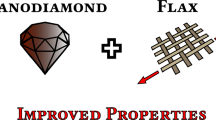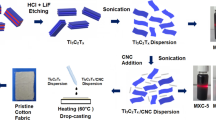Abstract
Detonation nanodiamonds are gaining considerable research interest due to their superior hardness, excellent mechanical properties, large surface area and small size. Surface functionality of polymeric, fibrous materials and nanocomposites can be significantly improved by application of nanodiamonds. Although there has been some research on nanodiamonds in polymeric materials and composites available, research on fibrous materials, such as textiles, is limited. We investigated potential improvement in the properties of cotton materials after application of nanodiamonds. Nanodiamonds were applied to cotton fabric using a sustainable dip-coating laboratory technique, which was then characterized for improved functionality in such properties as strength, elongation, thermal stability and surface energy. It was observed that a surface coating of nanodiamonds enhanced the tensile strength of the cotton by 79%, without compromising the flexibility of the substrate significantly, due to the exceptional mechanical properties of the nanodiamond particles and strong bonding between fibers and yarns within the fabric. High thermal conductivity of the nanodiamonds resulted in increased thermal stability and a higher degradation temperature in the coated substrate, when compared with the uncoated cotton fabric. Scanning electron microscopy images indicated that the coated cotton fabric displayed a coarser surface than the uncoated fabric. Coated fabric also absorbed more energy than uncoated fabric during repeated deformation in abrasion testing, due to presence of nanodiamond which resulted in imporvement of abrasion resistance.






Similar content being viewed by others
References
Abbas R, Khereby MA, Sadik WA, El Demerdash AGM (2014) Fabrication of durable and cost effective superhydrophobic cotton textiles via simple one step process. Cellulose 22(1):887–896
Akaydın M (2010) Pilling performance and abrasion characteristics of selected basic weft knitted fabrics. Fibres Text East Eur 18:79
Aleksenskiy AE, Eydelman ED, Vul AY (2011) Deagglomeration of detonation nanodiamonds. Nanosci Nanotechnol Lett 3:68–74
Bhadra M, Roy S, Mitra S (2014) Nanodiamond immobilized membranes for enhanced desalination via membrane distillation. Desalination 341:115–119
Caschera D, Cortese B, Mezzi A et al (2013) Ultra hydrophobic/superhydrophilic modified cotton textiles through functionalized diamond-like carbon coatings for self-cleaning applications. Langmuir 29:2775–2783
Çelik N, Değirmenci Z, Kaynak HK (2010) Effect of nano-silicone softener on abrasion and pilling resistance and color fastness of knitted fabrics. Tekstil ve Konfeksiyon 1:41–47
Chattopadhyay D, Inamdar MS (2013) Improvement in properties of cotton fabric through synthesized nano-chitosan application. Indian J Fibre Text Res 38:14–21
Das T, Ramaswamy GN (2016) Enzyme treatment of wool and specialty hair fibers. Text Res J 76:126–133
Ekimov EK, Gromnitskaya EL, Mazalov DA, Pal’ VAF, Pichugin SV, Gierlotka B, Palosz J, Kozubowski A (2004) Microstructure and mechanical characteristics of nanodiamond-SiC compacts. Phys Solid State 46(4):755–757
Haule LV, Rigout M, Carr CM, Jones CC (2012) Surface and bulk chemical analysis of the durability of an easy care finish on cotton. Cellulose 19(3):1023–1030
Höcker H (2002) Plasma treatment of textile fibers. Pure Appl Chem 74:423–427
Kan CW, Lam YL (2013) Low stress mechanical properties of plasma-treated cotton fabric subjected to zinc oxide-antimicrobial treatment. Materials (Basel) 6:314–333
Kan CW, Yuen CWM (2016) Low temperature plasma treatment for wool fabric. Text Res J 76:309–314
Koltysheva NG, Lomov SV, Truevtzev NN (2004) Abrasion resistance of cotton/flax fabrics: 3D computer simulations of fabric wear geometry. AUTEX Res J 4:182–186
Kousar Y, Ali N, Neto VF et al (2004) Deposition of nanocrystalline diamond and titanium oxide coatings onto pyrolytic carbon using CVD and sol–gel techniques. Diam Relat Mater 13:638–642
Krueger A, Lang D (2012) Functionality is Key: recent progress in the surface modification of nanodiamond. Adv Funct Mater 22:890–906
Kumar A, Ann Lin P, Xue A, Hao B, Khin Yap Y, Sankaran RM (2013) Formation of nanodiamonds at near-ambient conditions via microplasma dissociation of ethanol vapour. Nat Commun 4:2618
Lao L, Fu L, Qi G et al (2017) Superhydrophilic wrinkle-free cotton fabrics via plasma and nanofluid treatment. ACS Appl Mater Interfaces 9:38109–38116
Liu L, Chen J, Zhu B et al (2006) The yarn-to-yarn friction of woven fabrics. In: 9th international ESAFORM conference on materials forming, UK
Liu H, Huang J, Li F, Chen Z, Zhang K, Al-Deyab S, Lai Y (2017) Multifuncational superamphiphobic fabrics with asymmetric wettability for one-way fluid transport and templated patterning. Cellulose 24(2):1129–1141
Lu Y, Jia Y, Zhang G, Zhang F (2018) An eco-friendly intumescent flame retardant with high efficiency and durability for cotton fabric. Cellulose. https://doi.org/10.1007/s10570-018-1930-0
Nayak R, Padhye R (2014) The care of apparel products. In: Sinclair R (ed) Textiles and fashion. Elsevier, Amsterdam, pp 799–822
Nilgün Ö, Gonca Ö, Gamze K et al (2012) Analysis of abrasion characteristics in textiles. In: Adamiak DM (ed) Abrasion resistance of materials. InTech, Rijeka
Örtlek HG, Yolaçan G, Bilget Ö et al (2010) Effects of enzymatıc treatment on the performance of knıtted fabrıcs made from dıfferent yarn types. Tekstil ve Konfeksiyon 2:115–119
Osenberg F, Theirich D, Decker A et al (1999) Process control of a plasma treatment of wool by plasma diagnostics. Surf Coat Technol 116–119:808–811
Reineck P, Lau DWM, Wilaon E, Fox K, Field M, Deeleepojananan C, Mochalin V, Gibson B (2017) Effect of surface chemistry on the flurescence of detonation nanodiamonds. ACS Nano 11:10924–10934
Santra TS, Bhattacharyya TK, Patel P, Tseng FG, Barik TK (2012) Diamond, diamond-like carbon (DLC) and diamond-like nanocomposite (DLN) thin films for MEMS applications. In: Islam DN (ed) Microelectromechanical systems and devices. InTech, Rijeka
Shenderova O, Panich AM, Moseenkov S, Hens SC, Kuznetsov V, Wieth HM (2011) Hydroxylated detonation nanodiamond: FTIR, XPS, and NMR studies. J Phys Chem C 115:19005–19011
Sun D (2017) Investigation into abrasion resistance of dyed fabrics made of recycled and standard cotton fibres. J Text Eng Fash Technol. https://doi.org/10.15406/jteft.2017.01.00006
Sun D, Wang W, Yu D (2017) Highly hydrophobic cotton fabrics prepared with fluorine-free functionalized silsesquioxanes. Cellulose 24:4519–4531
Wu J, Li J, Deng B et al (2013) Self-healing of the superhydrophobicity by ironing for the abrasion durable superhydrophobic cotton fabrics. Sci Rep 3:2951
Zhang R, Wang A (2015) Modification of wool by air plasma and enzymes as a cleaner and environmentally friendly process. J Clean Prod 87:961–965
Author information
Authors and Affiliations
Corresponding author
Additional information
Publisher's Note
Springer Nature remains neutral with regard to jurisdictional claims in published maps and institutional affiliations. I would like to add extra aknowledgment to the previous aknowledgment to Centre for Nanoscale BioPhotonics, RMIT University.
Rights and permissions
About this article
Cite this article
Houshyar, S., Nayak, R., Padhye, R. et al. Fabrication and characterization of nanodiamond coated cotton fabric for improved functionality. Cellulose 26, 5797–5806 (2019). https://doi.org/10.1007/s10570-019-02479-w
Received:
Accepted:
Published:
Issue Date:
DOI: https://doi.org/10.1007/s10570-019-02479-w




